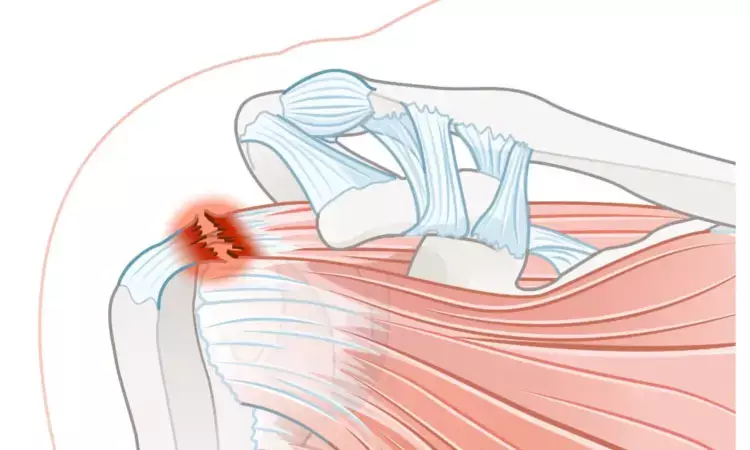- Home
- Medical news & Guidelines
- Anesthesiology
- Cardiology and CTVS
- Critical Care
- Dentistry
- Dermatology
- Diabetes and Endocrinology
- ENT
- Gastroenterology
- Medicine
- Nephrology
- Neurology
- Obstretics-Gynaecology
- Oncology
- Ophthalmology
- Orthopaedics
- Pediatrics-Neonatology
- Psychiatry
- Pulmonology
- Radiology
- Surgery
- Urology
- Laboratory Medicine
- Diet
- Nursing
- Paramedical
- Physiotherapy
- Health news
- Fact Check
- Bone Health Fact Check
- Brain Health Fact Check
- Cancer Related Fact Check
- Child Care Fact Check
- Dental and oral health fact check
- Diabetes and metabolic health fact check
- Diet and Nutrition Fact Check
- Eye and ENT Care Fact Check
- Fitness fact check
- Gut health fact check
- Heart health fact check
- Kidney health fact check
- Medical education fact check
- Men's health fact check
- Respiratory fact check
- Skin and hair care fact check
- Vaccine and Immunization fact check
- Women's health fact check
- AYUSH
- State News
- Andaman and Nicobar Islands
- Andhra Pradesh
- Arunachal Pradesh
- Assam
- Bihar
- Chandigarh
- Chattisgarh
- Dadra and Nagar Haveli
- Daman and Diu
- Delhi
- Goa
- Gujarat
- Haryana
- Himachal Pradesh
- Jammu & Kashmir
- Jharkhand
- Karnataka
- Kerala
- Ladakh
- Lakshadweep
- Madhya Pradesh
- Maharashtra
- Manipur
- Meghalaya
- Mizoram
- Nagaland
- Odisha
- Puducherry
- Punjab
- Rajasthan
- Sikkim
- Tamil Nadu
- Telangana
- Tripura
- Uttar Pradesh
- Uttrakhand
- West Bengal
- Medical Education
- Industry
Transosseous repair technique as effective as single row anchor repair for rotator cuff tear: study

Transosseous repair (TO) has declined in popularity since the introduction of suture anchors and arthroscopic methods in 1985. Nevertheless, failure rates remain significant, at 12% to 40% and the cost of these devices is considerable. Consequently, interest has revived in arthroscopic transosseous technique, Julio Solis Kronthal et al conducted a study to evaluate whether anchorless transosseous arthroscopic fixation achieves similar or better functional outcomes than single-row fixation with anchors in patients with rotator cuff tears.
60 shoulders with complete rotator cuff tears were evaluated, divided into two groups based on fixation technique: Group 1 (transosseous) and Group 2 (single row with anchors). All patients had a minimum 12-month follow-up, including clinical assessments (VAS, range of motion) and functional questionnaires (ASES, Constant scores). The study has been published in ‘International Journal of Research in Orthopaedics’
Key findings of the study were:
• No significant differences were found in VAS scores at 6 months (t=0.244, p=0.404) and 12 months (t=0.220, p=0.413).
• There was no superiority of either group in motion ranges at 12 months (forward flexion t=0.732, p=0.234; external rotation t=1.608, p=0.057; abduction t=0.583, p=0.281).
• Both groups reported high postoperative satisfaction, with no differences in ASES (t=0.153, p=0.439) and constant scores (t=0.572, p=0.285) at 12 months.
“In conclusion, this study demonstrates that, when evaluating functional outcomes, pain and range of motion at 12 months postoperatively, the transosseous repair technique is comparable in effectiveness to the single-row anchor repair for rotator cuff repair. These findings advocate for the routine implementation of the transosseous technique, particularly in patients with limited access to healthcare resources. However, further comparative studies with extended follow-up periods and larger sample sizes are warranted. Additionally, a cost-effectiveness analysis is essential to assess the economic viability and benefit-to-cost ratio of both therapeutic approaches” the authors commented.
Further reading:
Functional outcomes of arthroscopic rotator cuff repair: transosseous technique versus single-row with anchors, Julio Solis Kronthal et al Int J Res Orthop. 2025 May;11(3):491-497.
MBBS, Dip. Ortho, DNB ortho, MNAMS
Dr Supreeth D R (MBBS, Dip. Ortho, DNB ortho, MNAMS) is a practicing orthopedician with interest in medical research and publishing articles. He completed MBBS from mysore medical college, dip ortho from Trivandrum medical college and sec. DNB from Manipal Hospital, Bengaluru. He has expirence of 7years in the field of orthopedics. He has presented scientific papers & posters in various state, national and international conferences. His interest in writing articles lead the way to join medical dialogues. He can be contacted at editorial@medicaldialogues.in.


